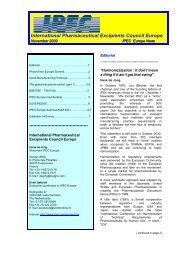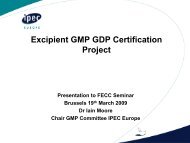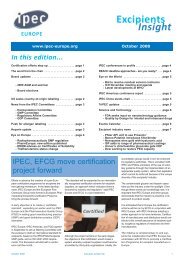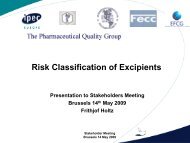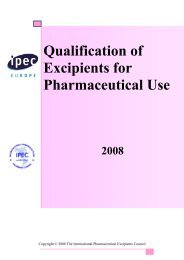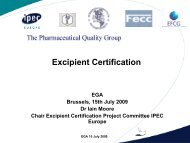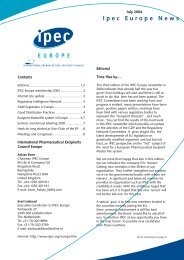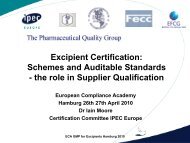International Pharmaceutical Excipients Council ... - IPEC Europe
International Pharmaceutical Excipients Council ... - IPEC Europe
International Pharmaceutical Excipients Council ... - IPEC Europe
Create successful ePaper yourself
Turn your PDF publications into a flip-book with our unique Google optimized e-Paper software.
<strong>International</strong> <strong>Pharmaceutical</strong> <strong>Excipients</strong> <strong>Council</strong> <strong>Europe</strong><br />
April 2003 <strong>IPEC</strong> <strong>Europe</strong> News<br />
Contents<br />
A Journey to the Centre of the Earth… .......… .1,2<br />
<strong>IPEC</strong> position papers: Purpose and content<br />
of a compendial monograph .… …………………2<br />
<strong>IPEC</strong> <strong>Europe</strong> … ………………..… ………….… ….3<br />
Member profiles Akzo Nobel … …….… . .… ……4<br />
Good Distribution Practices… ……………………5<br />
Luzenac: talc for the world… ……………….… 5<br />
Enlargement of the <strong>Europe</strong>an Union:<br />
Hungary… ………………………………………….6<br />
Meetings and Congresses… ….… …. … ……..... 8<br />
******************************************<br />
<strong>International</strong> <strong>Pharmaceutical</strong><br />
<strong>Excipients</strong> <strong>Council</strong> <strong>Europe</strong><br />
Henk de Jong<br />
Chairman <strong>IPEC</strong> <strong>Europe</strong><br />
Servier<br />
6, Place des Pleiades<br />
92415 Courbevoie<br />
France<br />
Tel +33-1-5572 6178<br />
Fax +33-1-5572 7671<br />
E-mail: hendrik.dejong@fr.netgrs.com<br />
Evert Izeboud<br />
Executive coordinator to <strong>IPEC</strong> <strong>Europe</strong><br />
Kerkweide 27<br />
2265 DM Leidschendam<br />
The Netherlands<br />
Tel +31-70-320 9894<br />
Fax +31-70-320 3759<br />
E mail: eizeboud@worldonline.nl<br />
Internet: http://www.ipec.org/europe.htm<br />
Editorial<br />
A Journey to the Centre of the<br />
Earth<br />
Henk J. de Jong<br />
Even Jules Verne when publishing his novel:<br />
« Voyage au Centre de la Terre » in 1864,<br />
with all his fantasy and imagination did not<br />
predict that delegations from <strong>IPEC</strong>-Americas<br />
(Chris Moreton, Janeen Kincaid) and <strong>IPEC</strong>-<br />
<strong>Europe</strong> (Undine Kettenring, Henk de Jong)<br />
would participate by invitation from their<br />
JPEC colleagues (Mrs. Kijima, Watanabe,<br />
Kokubo, Myamoto and Saisho) in an<br />
excursion to the Centre of the Earth.<br />
This trip took place between the Tri-PEC<br />
and the Tri-PEC / PDG meetings in a<br />
recently build volcano at Tokyo-Disney,<br />
close to the venue for the ICH and PDG<br />
meetings held in early February 2003.<br />
The highlights from our meetings are<br />
reported briefly here :<br />
- Since the harmonization effort (first round)<br />
is reaching 49 out of 51 (harmonization by<br />
attributes), a new priority rating for<br />
additional monographs was discussed.<br />
PDG will inform Tri-PEC about the<br />
programme and the choice of the<br />
coordinating Pharmacopoeia for each<br />
proposed new item.<br />
- PDG has accepted to indicate clearly in<br />
future editions of their respective books<br />
which parts of monographs are<br />
harmonized. USP and Ph. Eur. will do this<br />
by printing a distinctive sign (a lozenge) in<br />
the margin. JP will publish a general<br />
chapter explaining the situation.<br />
(to be continued on page 2)
<strong>International</strong> <strong>Pharmaceutical</strong> <strong>Excipients</strong> <strong>Council</strong> <strong>Europe</strong><br />
________________________________________________________________<br />
(continued from page 1)<br />
- Round Robin testing to resolve « sticking<br />
points ».<br />
The effort on Anhydrous Dibasic Calcium<br />
Phosphate last year was full of mysteries. A<br />
new protocol was written and procedures<br />
clearly defined in a step by step way.<br />
Tri-PEC Lunch at the "Centre of the Earth"<br />
- Interchangeability of « equivalent »<br />
methods.<br />
Tri-PEC insisted a lot on having<br />
interchangeability « declared » in the<br />
framework of harmonization. PDG has<br />
the opinion that acceptance of<br />
interchangeability is with the regulatory<br />
authorities. Both PDG and Tri-PEC will<br />
work on clarification of this important<br />
point e.g. <strong>IPEC</strong>-<strong>Europe</strong> with Ph. Eur. and<br />
EMEA / QWP.<br />
- Impurity Guidance<br />
<strong>IPEC</strong>-Americas and <strong>IPEC</strong>-<strong>Europe</strong> will<br />
strive for a common guidance to address<br />
their members’ need. Once a draft is<br />
available it will be shared with JPEC.<br />
- The Common Technical Document will<br />
have an impact on all new submissions.<br />
Undine Kettenring and Henk de Jong will<br />
collect experiences with CTD<br />
submissions and organise (part of) a<br />
seminar on this.<br />
- <strong>IPEC</strong>-Americas have asked for input as<br />
to what are the preferred sieving<br />
methods in <strong>Europe</strong> and Japan. Please<br />
provide feed back to<br />
undine.kettenring@pharma.novartis.com<br />
P.M. the USP methods are : Dry<br />
Sieving, Wet Sieving, Alpine Edger,<br />
Sonic Sifter.<br />
- The pharmacopoeial fora will publish 1)<br />
the article of Andersson et al. on NMR<br />
determination of hydroxypropoxy content<br />
in HPC and 2) the policy paper on the<br />
purpose of excipient monographs. Both<br />
articles did appear in the April issue of<br />
Pharmeuropa (15.2).<br />
- The <strong>International</strong> Non proprietory<br />
Names (INNs) for excipients do<br />
unfortunately not have a high priority<br />
among Tri-PEC and PDG. Chris<br />
Moreton and Henk de Jong will, through<br />
a step by step approach, try to make<br />
some progress directly with WHO.<br />
- PDG promised to define and transmit a<br />
list of outstanding « Sticky points) where<br />
Tri-PEC could help to find solutions.<br />
As you will have noticed from the above, this<br />
trip to the core of the world was full of<br />
surprises and lucky escapes, thus : we<br />
survived and decided to engage in the next<br />
Tri-PEC / PDG / meeting : Brussels July16,<br />
2003<br />
<strong>IPEC</strong> position papers<br />
The purpose and content of an excipient<br />
monograph(1)<br />
During the past two years a lot of work has<br />
been done by the three <strong>IPEC</strong> associations<br />
on elaborating a position paper on the<br />
purpose and contents of a compendial<br />
monograph for pharmaceutical excipients. A<br />
summary of the essentials of the position<br />
paper is given below, while the whole text<br />
will be published in the Pharmacopoeial<br />
Fora in Japan, The United States and<br />
<strong>Europe</strong> (Pharmeuropa, 15.2, April 2003).<br />
______________________________________________________________________________________<br />
April 2003 2 <strong>IPEC</strong> <strong>Europe</strong> News<br />
________________________________________________________________
<strong>International</strong> <strong>Pharmaceutical</strong> <strong>Excipients</strong> <strong>Council</strong> <strong>Europe</strong><br />
________________________________________________________________<br />
Implementation of the contents of this<br />
position paper in the pharmacopoeial<br />
compendia will contribute significantly to the<br />
practical application of the monographs, i.e.<br />
a guarantee of the quality (assurance) of<br />
pharmaceutical excipients combined with a<br />
balance in the mandatory and non<br />
mandatory parameters of the monographs.<br />
Summary of the position paper<br />
Monographs for excipients should be<br />
designed to ensure the safe use of these<br />
materials when used in pharmaceutical<br />
preparations. Criteria should also be defined<br />
to give consistent quality. Hence in addition<br />
to requirements for identity and purity (limits<br />
for harmful or destabilizing impurities),<br />
functionality-related properties should be<br />
considered.<br />
Functionality related properties for a specific<br />
excipient may vary for different medicinal<br />
products. Therefore no binding limits for<br />
functionality-related properties should be<br />
included in a pharmacopoeial monograph.<br />
Functionality-related property testing should<br />
be not be-mandatory. It should be reported<br />
in the product labelling, with reference to the<br />
test method used. If available a general<br />
method described in a pharmacopoeia is<br />
preferred. Any limits for relevant<br />
functionality-related properties should be<br />
agreed between the user and the supplier.<br />
<strong>IPEC</strong> <strong>Europe</strong><br />
Evert Izeboud<br />
An important organisational event in 2002<br />
was the establishment of a standing<br />
committee for internal and external<br />
communication matters. Various preparatory<br />
meetings have resulted in a communication<br />
plan which was presented by Mr Herman<br />
Ermens during the Annual General Meeting<br />
on January 31 st 2003. The communication<br />
plan will focus on refreshing of the face of<br />
<strong>IPEC</strong> <strong>Europe</strong> in terms of a consistent house<br />
style and establishing of a professional<br />
public relations policy (excipients articles,<br />
press releases etc). This effort will also<br />
relate to the presentation of <strong>IPEC</strong> <strong>Europe</strong>’s<br />
Newsletter. Articles will be published on the<br />
company profiles of <strong>IPEC</strong> <strong>Europe</strong> members,<br />
starting in this issue with Akzo-Nobel.<br />
<strong>IPEC</strong> <strong>Europe</strong> Board<br />
Mr Adrian Bone was elected to serve as a<br />
member of the <strong>IPEC</strong> <strong>Europe</strong> Board at the<br />
meeting held in Amsterdam in January.<br />
2003. Adrian, a registered pharmacist is an<br />
employee of Eli Lilly and Company based in<br />
the UK where he has held many positions in<br />
Lilly's Quality component in several<br />
countries, spanning a career of over 20<br />
years<br />
Dr Adrian Bone,<br />
<strong>IPEC</strong> <strong>Europe</strong> Board member<br />
Adrian is currently a Manager in the<br />
company's Corporate Quality Assurance<br />
Division, with a specific responsibility for the<br />
quality standards associated with in-coming<br />
components (which includes excipients). At<br />
the moment, he is involved in an interindustry<br />
group considering the possibility of<br />
sharing vendor audit reports.<br />
(to be continued on page 4)<br />
______________________________________________________________________________________<br />
April 2003 3 <strong>IPEC</strong> <strong>Europe</strong> News<br />
________________________________________________________________
<strong>International</strong> <strong>Pharmaceutical</strong> <strong>Excipients</strong> <strong>Council</strong> <strong>Europe</strong><br />
________________________________________________________________<br />
( continued from page 3)<br />
This concept offers significant advantages to<br />
both pharmaceutical companies and<br />
suppliers but also considerable challenges<br />
when issues such a auditor consistency and<br />
liability are considered. Adrian has been part<br />
of industry groups and committees covering<br />
a wide range of subjects, including drafting<br />
the <strong>Pharmaceutical</strong> Quality Groups'<br />
monograph PS 9000:2001 - <strong>Pharmaceutical</strong><br />
Packaging Materials.<br />
More recently he has been involved in PERF<br />
II (Pan <strong>Europe</strong>an Regulatory Forum) and the<br />
issues facing candidate countries applying to<br />
join the EU in 2004.<br />
<strong>IPEC</strong> <strong>Europe</strong> membership<br />
The year 2003 started with a number of<br />
mergers/take overs which affected the <strong>IPEC</strong><br />
<strong>Europe</strong> membership. Avebe’s excipients<br />
business was acquired by DMV <strong>International</strong><br />
while Pharmacia now is part of Pfizer. Due<br />
to a reorganisation in business orientation<br />
Royal Cosun (Netherlands) has terminated<br />
its membership.<br />
In February 2003 the Board endorsed the<br />
application of Luzenac the worlds largest<br />
supplier of talc. An article on Luzenac is<br />
published on page 5 of this newsletter.<br />
During the Board meeting on April 11 th 2003<br />
the application of the French company SPI<br />
Pharma was endorsed. The company profile<br />
of SPI Pharma will be published in the July<br />
Newsletter.<br />
The <strong>IPEC</strong> <strong>Europe</strong> membership currently<br />
counts 68 full members, 4 associated<br />
members and 1 co-opted member.<br />
<strong>IPEC</strong> <strong>Europe</strong> membership profiles<br />
Under the heading Membership profiles an<br />
attempt will be made to inform the <strong>IPEC</strong><br />
<strong>Europe</strong> membership about the major<br />
activities (<strong>Excipients</strong>) of the members. A<br />
start will be made with Akzo-Nobel a maker<br />
of pharmaceutical excipients.<br />
Akzo-Nobel based in the Netherlands,<br />
serves the customers throughout the world<br />
with healthcare products, coatings and<br />
chemicals. Akzo-Nobel is one of the <strong>IPEC</strong><br />
<strong>Europe</strong> members which manufacturers the<br />
excipient Sodium Carboxymethylcellulose<br />
(EP: Carmellose Sodium) , which finds<br />
applications in key market sectors such as<br />
pharmaceutical and food products.<br />
Carmellose Sodium can act as a thickener<br />
and stabilizer, but also as a moisture binder<br />
and gelling agent. Carmellose Sodium is<br />
widely used in oral and topical<br />
pharmaceutical formulations primarily for its<br />
viscosity-increasing properties. Viscous<br />
aqueous solutions are used to suspend<br />
powders intended for either<br />
topical application and oral and parenteral<br />
administration. Carmellose Sodium may<br />
also be used as a tablet binder or<br />
disintegrant, and or to stabilize emulsions.<br />
Specialty grades are available to produce<br />
gels which can be used as a base for<br />
various applications. Carmellose Sodium is<br />
additionally one of the main ingredients of<br />
self-adhesive ostomy, wound care, and<br />
dermatological patches where it is used to<br />
absorb wound extrudate or transepidermal<br />
water and sweat.<br />
Akzo Nobel<br />
Representative to <strong>IPEC</strong> <strong>Europe</strong><br />
Mr Theo van ‘t Zelfde<br />
Tel: +31-33-467 6757<br />
Fax +31-33-467 6118<br />
E-mail: Theo.vantZelfde@akzonobel.com<br />
______________________________________________________________________________________<br />
April 2003 4 <strong>IPEC</strong> <strong>Europe</strong> News<br />
________________________________________________________________
<strong>International</strong> <strong>Pharmaceutical</strong> <strong>Excipients</strong> <strong>Council</strong> <strong>Europe</strong><br />
________________________________________________________________<br />
Good Distribution Practices (GDP)<br />
Frank Milek<br />
<strong>IPEC</strong> <strong>Europe</strong>´s Good Distribution Practice<br />
Committee prepared together with <strong>IPEC</strong><br />
Americas a draft document entitled<br />
“Guidelines on Good Distribution Practices<br />
(GDP) of Bulk <strong>Pharmaceutical</strong> <strong>Excipients</strong>”.<br />
As presented at the <strong>IPEC</strong> <strong>Europe</strong> Annual<br />
Meeting (31.01.03) in Amsterdam, this draft<br />
had been elaborated during the last year. It<br />
is a complementary document to the “<strong>IPEC</strong><br />
GMP Guidelines for Bulk <strong>Pharmaceutical</strong><br />
<strong>Excipients</strong>”. The present draft also takes into<br />
account the ideas of WHO’s "Good Trade<br />
and Distribution of <strong>Pharmaceutical</strong> Starting<br />
Materials" (GTDP) document, CEFIC´s<br />
"Guidelines for the Distribution of Propylene<br />
Glycol EP/USP", CEFIC/FECC "<strong>Europe</strong>an<br />
Single Assessment for Chemical<br />
distributors" and the commonly recognized<br />
necessity to define some Good Practices for<br />
the global distribution of excipients<br />
especially in case of repackaging and<br />
relabeling activities carried out through the<br />
supply chain. The main aims of these GDPs<br />
are to ensure full traceability and to avoid<br />
any contamination or adulteration of<br />
excipients through the supply chain of<br />
excipients, which is in the best interests of<br />
the excipients manufacturers and users.<br />
This draft document has been distributed to<br />
the whole <strong>IPEC</strong> <strong>Europe</strong> membership for<br />
comments And several comments have<br />
been received to date. During future<br />
meetings the Committee will revise the draft<br />
taking the members comments into account.<br />
Furthermore it is intended to work closely<br />
together with <strong>IPEC</strong> Americas. And indeed<br />
the Committee is waiting for comments from<br />
<strong>IPEC</strong> Americas on the current draft.<br />
On March 10-14 th<br />
the WHO Expert<br />
Committee on Specifications for<br />
<strong>Pharmaceutical</strong> Preparations met in<br />
Geneva, where the Expert Committee<br />
accepted the current draft of the working<br />
document on "Good Trade and Distribution<br />
Practice for <strong>Pharmaceutical</strong> Starting<br />
materials" (QAS/01.014/Rev2). The draft<br />
now will only be reviewed by WHO editors<br />
and before final approval by the WHO<br />
Executive Board (A group of UN 32 member<br />
states) in January 2004. The document will<br />
then be officially available for publication.<br />
Therefore some slight changes of the<br />
wording are possible. This document is inline<br />
with <strong>IPEC</strong>´s activities on GDP for<br />
excipients, e.g:<br />
- Traceability back to the original<br />
manufacturer throughout the whole supply<br />
chain<br />
- No up-grading of non-pharmaceutical<br />
grade to pharmaceutical grade material<br />
- Appropriate standards for repackaging and<br />
packaging materials<br />
- Appropriate requirements for quality control<br />
and Certificates of Analysis<br />
- Appropriate measures against crosscontamination<br />
FECC´s (<strong>Europe</strong>an Association of Chemical<br />
Distributors Associations) GMP-Committee<br />
is working on an official position of the<br />
association on Good Distribution Practice of<br />
<strong>Pharmaceutical</strong> Starting Materials. They see<br />
the necessity of improvement and want to<br />
adapt the above mentioned WHO GTDP as<br />
the basis of their work and official position.<br />
These different activities on GDP are<br />
highlighting the importance of this topic for<br />
the supply chain of pharmaceutical starting<br />
materials. The outcome of the different<br />
activities will be reported in future <strong>IPEC</strong><br />
<strong>Europe</strong> Newsletters.<br />
Luzenac Group is the world's number one<br />
talc producer, with over thirty mines and<br />
processing plants in <strong>Europe</strong>, America,<br />
Canada, Mexico and Australia. As leader, it<br />
is committed to setting the standards for the<br />
talc industry in such areas as innovation,<br />
technical assistance, product quality, health<br />
safety and environment, and ethical<br />
behaviour.With the widest talc product range<br />
and significant applications expertise,<br />
Luzenac is the only talc producer that can<br />
meet all end-use requirements worldwide.<br />
______________________________________________________________________________________<br />
April 2003 5 <strong>IPEC</strong> <strong>Europe</strong> News<br />
________________________________________________________________
<strong>International</strong> <strong>Pharmaceutical</strong> <strong>Excipients</strong> <strong>Council</strong> <strong>Europe</strong><br />
________________________________________________________________<br />
The Group produces over 1.4 million tonnes<br />
of talc and talc-related minerals a year and For Additional Information on Talc<br />
serves some 10,000 customers worldwide,<br />
in industries as diverse as coatings, paper, Luzenac <strong>Europe</strong><br />
plastics, ceramics, rubber, animal feed and BP 1162 31036 Toulouse Cedex 1<br />
personal care.<br />
France<br />
What is talc ?<br />
Talc is our planet’s softest mineral. It is a<br />
hydrated magnesium silicate<br />
(Mg 3 Si 4 0 10 (0H) 2 ). Although talcs differ<br />
slightly according to the associated minerals<br />
present in the ore-body, all talcs exhibit to a<br />
lesser or greater extent the following unique<br />
features: softness, hydrophobicity,<br />
inertness, platyness, and organophilicity (an<br />
affinity for certain organic chemicals). These<br />
properties provide specific functions in a<br />
whole range of applications.<br />
Luzenac has reached its current status<br />
through a high rate of new product and<br />
application innovation. Luzenac’s philosophy<br />
is to provide customers with innovative<br />
products and services while operating to the<br />
highest health, safety and environmental<br />
standards.<br />
Luzenac’s mountain-top mine in the<br />
French Pyrenees<br />
Dr Didier Arseguel<br />
Representative to <strong>IPEC</strong> <strong>Europe</strong><br />
Tel +33-561 562020<br />
Fax+33-561 502000<br />
E-mail: didier.arseguel@europe.luzenac.com<br />
Enlargement of the <strong>Europe</strong>an Union<br />
On April 16 th 2003 important progress was<br />
made with regard to enlargement of the<br />
<strong>Europe</strong>an Union: a treaty was signed off by<br />
candidate member states to join the <strong>Europe</strong>an<br />
Union in 2004. <strong>IPEC</strong> <strong>Europe</strong>’s Communication<br />
Committee has decided to publish small<br />
articles with, where possible, an overview of<br />
the consequences for the market possibilities<br />
for pharmaceutical excipients. This Newsletter<br />
focuses on Hungary, a candidate EU member<br />
with a significant pharmaceutical industry.<br />
Hungary<br />
Source:<br />
Hungarian Ministry of Economic Affairs<br />
The Hungarian pharmaceutical industry plays<br />
a highly important role both in the economy<br />
and in health care provision. It has a tradition<br />
of more than 100 years and is one of the most<br />
competitive branches of the Hungarian<br />
industry. Its share of the gross value of<br />
industrial output was 2.4 per cent in 1998.<br />
However, the significance of the sector is<br />
much greater than the quantity figures<br />
suggest, if the innovative and structural<br />
modernization efforts are also taken into<br />
account. Hungarian pharmaceutical<br />
companies contributed significantly to the<br />
progress of the sector, by investing HUF 81<br />
billion in it in general and HUF 41 billion in<br />
research and development in the period<br />
between 1994-1998.<br />
______________________________________________________________________________________<br />
April 2003 6 <strong>IPEC</strong> <strong>Europe</strong> News<br />
________________________________________________________________
<strong>International</strong> <strong>Pharmaceutical</strong> <strong>Excipients</strong> <strong>Council</strong> <strong>Europe</strong><br />
________________________________________________________________<br />
The companies of the pharmaceutical sector<br />
are engaged in the production of the following<br />
product categories: human pharmaceuticals<br />
(including active ingredients and finished<br />
drugs), veterinary medicines, fine chemicals,<br />
intermediates of pharmaceuticals and<br />
pesticides, insecticides, laboratory chemicals<br />
and diagnostic products, as well as vitamin<br />
containing food supplements and<br />
paramedicines. Several pharmaceutical<br />
companies run other lines of business (e.g.<br />
cosmetics); however, pharmaceutical<br />
products play a decisive role both in<br />
production and strategic development.<br />
The pharmaceutical market can be divided<br />
into 3 large product categories. The largest<br />
one consists of prescription-only, patented<br />
pharmaceuticals with a registered name.The<br />
second group is made up of over- the-counter<br />
(or OTC) drugs - these products are sold in<br />
pharmacies but do not require a prescription.<br />
Typical drugs belonging to this group include<br />
analgesics, laxatives, products against sore<br />
throat and other minor infections, and<br />
vitamins. The third group consists of the socalled<br />
generic products. These products have<br />
the same active ingredient and quality as the<br />
originals but being off patent, they are priced<br />
much lower and often do not have a brand<br />
name. Beside medicines, paramedicines and<br />
natural substances that cannot be patented<br />
are also produced as generics.<br />
Major player in the market<br />
There are four Hungarian manufacturers<br />
among the top ten companies that account<br />
for almost half of the domestic sales of<br />
pharmaceuticals. Richter Gideon Rt is the<br />
largest pharmaceutical company in Hungary<br />
manufacturing about 100 preparations in<br />
140 dosage forms and pack sizes. These<br />
products cover the most important<br />
therapeutic fields and most of them have<br />
been developed by Richter itself. The<br />
success of research and development<br />
activities are shown by the fact that almost<br />
one-fourth of the total sales is generated by<br />
products originating within the company.<br />
Richter sells about two-third of its production<br />
on foreign markets. Richter has especially<br />
strong presence in Eastern <strong>Europe</strong> , where it<br />
is the largest foreign supplier of<br />
pharmaceuticals.<br />
3 rd <strong>International</strong> Symposium on<br />
<strong>Excipients</strong><br />
The 3 rd <strong>International</strong> Symposium on<br />
<strong>Excipients</strong> for non-parenteral Dosage Forms<br />
is arranged by the Swedish Academy of<br />
<strong>Pharmaceutical</strong> Sciences in co-operation<br />
with <strong>IPEC</strong> <strong>Europe</strong>.<br />
The symposium is intended for people<br />
concerned with design, production and<br />
quality assurance of pharmaceutical dosage<br />
forms. Mr Henk de Jong is a member of the<br />
organizing Committee and will present a<br />
lecture on “Considerations relating to the<br />
development of novel excipients”<br />
______________________________________________________________________________________<br />
April 2003 7 <strong>IPEC</strong> <strong>Europe</strong> News<br />
________________________________________________________________
<strong>International</strong> <strong>Pharmaceutical</strong> <strong>Excipients</strong> <strong>Council</strong> <strong>Europe</strong><br />
________________________________________________________________<br />
Meetings and Seminars 2003<br />
Calendar of Meetings and Seminars<br />
May 12 th and 13 th<br />
Drug Information Association<br />
Active <strong>Pharmaceutical</strong> Ingredients and<br />
Starting Materials , Rome, Italy<br />
June 1 st - 4 th<br />
United States Pharmacopeia<br />
Analytical Methods and General USP<br />
topics<br />
Philadelphia, United States<br />
July 4 th<br />
<strong>IPEC</strong> <strong>Europe</strong> Board Meeting<br />
Paris, France<br />
September 8 th and 9 th<br />
Swedish Academy of <strong>Pharmaceutical</strong><br />
Sciences<br />
3 rd <strong>International</strong> Symposium on<br />
<strong>Excipients</strong> for non-parenteral dosage<br />
forms.<br />
Stockholm, Sweden<br />
***********************************************<br />
Next <strong>IPEC</strong> <strong>Europe</strong> Newsletter<br />
The next Newsletter is scheduled to be<br />
issued in the month of July 2003.<br />
Call for text to be published<br />
<strong>IPEC</strong> <strong>Europe</strong> members who would like to<br />
contribute to the Newsletter are invited to<br />
submit text electronically (maximum 1 A4)<br />
to Mr Izeboud.<br />
<strong>IPEC</strong> <strong>Europe</strong> on the Internet<br />
http://www.ipec.org/europe.htm<br />
______________________________________________________________________________________<br />
April 2003 8 <strong>IPEC</strong> <strong>Europe</strong> News<br />
________________________________________________________________



